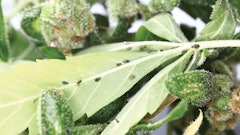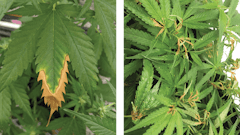
A revolutionary genetic technology that is being used to treat human diseases is also showing dramatic potential to transform cannabis production. The foundation for the technology, called
It also is being explored for a variety of agricultural applications. And more recently, it has made its way into the cannabis industry, with several patents being filed for various applications on the cannabis plant.
Most recently, on May 16, a provisional patent based on CRISPR, called Rapid Agrobacterium-Mediated Transformation and Gene Editing of Diverse Cannabaceae Species, was filed with the
According to MyFloraDNA, the technology promises to:
- redefine the landscape of crop varietal development and genetic improvement of cannabis crops,
- accelerate the integration of advanced genomic techniques into breeding solutions, crop enhancement, and delivery of superior traits to the market at a faster speed, and
- potentially revolutionize cannabis production, enabling growers to develop strains with specific properties more quickly and effectively. This would not only improve the quality of the final product, but also open new opportunities for research and development in the field of medicinal and recreational cannabis.
CRISPR vs. GMO Technology
While exploring the potential of this application, the first question that came to mind for me is: What is the difference between CRISPR technology and genetic engineering (the process used to create genetically modified organisms (GMOs))?
As it was explained to me by the scientists at MyFloraDNA, genetic modification involves inserting a gene from one organism into another, or in other words, utilizing recombinant DNA techniques to isolate and move the DNA from one organism to impart a desired trait to another—for example, for improved crop performance and productivity using
So, GMO modification involves adding a foreign gene to existing DNA, whereas CRISPRtechnology is an RNA-based system that involves gene editing —“cutting a DNA sequence at a specific genetic location and deleting or inserting DNA sequences, which can change a single base pair of DNA, large pieces of chromosomes, or regulation of gene expression levels,” according to the National Institutes of Health. It is referred to as a new genetic technology (NGT) and has been termed “the genetic scissors.”
In agriculture, common genetic modification (that produces GMOs) relies on the insertion of isolated genes or foreign DNA components into a plant genome. CRISPR gene editing, on the contrary, involves precise alteration of the existing genes/genomes within a crop.
CRISPR also is said to be
For instance, I asked the geneticists at MyFloraDNA how they would modify a cannabis plant so that it produced elevated levels of anthocyanin, thus producing a purple plant/buds; they explained that CRISPR technology could potentially be used to edit/eliminate the dominant genes that suppress the less dominant genes responsible for producing the genetic characteristics that produce anthocyanin/purple color. Removing/editing the dominant genes would result in the gene responsible for the purple color becoming the dominant gene. The same CRISPR concept could potentially apply to human eye color, or any other genetic trait that one wishes to accentuate, amplify or suppress, including sex, height, weight, disease susceptibility, elimination of genetic defects, etc.
The application of these “genetic scissors” has the potential to revolutionize cannabis in many respects. Besides the obvious—to elevate levels of terpenes and/or cannabinoids—there are insurmountable potential benefits with major future implications.
The University of California, Davis is also currently researching the use of CRISPR in many crops, such as lettuce, tomatoes, rice, strawberries or even grapes, where the scientists are trying to develop grape cultivars that are heat- and drought-resistant. This technology will eventually have a great impact on reducing the impacts of climate change on most agricultural crops.
Cannabis also is not capable of withstanding extreme temperatures and is not capable of rapidly adapting to tolerate extreme conditions that could potentially be experienced by growers in the future. In addition to cannabinoid and terpene modulation, heat and drought resistance, and color accentuation, CRISPR has the potential to produce plants that are resistant to multiple diseases, such as botrytis and powdery mildew, as well as to enhance yield, structure, growth rate, maturation time and virtually any/ all characteristics, such as pest resistance.
Potential for HLVd and Pest Resistance?
A 2021 study by Dark Heart Nursery found that 90% of the plants in California are infected with hop latent viroid (HLVd), and since the study was released, many viroid detection services have been developed, and clone providers have been advertising viroid-free genetics. This is one of the top priorities at MyFloraDNA, where their scientists are applying CRISPR to combat HLVd. Tissue culture labs also have begun advertising services to eliminate the viroid in a given cultivar. But once a cultivar is deemed pest or viroid free, it is still susceptible to potential reinfection over time. There is no guaranteed method to stay viroid- or pest-free forever. Some commercial plant cultivators—whether orchid flower or pineapple producers—utilize meristem tissue culture as source material to attempt to keep plants disease free, while others utilize UV sterilizing lights to try to keep mother plants viroid/disease free. But many growers keep a source of clean/uninfected plant material available in case pest/disease infection or infestation occurs.
Broad mites/russet mites are also rapidly becoming a real problem in the cannabis industry, especially with the current mass proliferation of genetics in clone form traversing the United States. I would estimate the losses due to pests and disease, combined, from the legal cannabis market would equal billions of dollars every year.
So, I have to wonder: What if CRISPR technology could enable production of a viroid-immune, pest-, disease- and drought-resistant, heat-tolerant cannabis plant, with increased growth rate and vigor, increased cannabinoid/terpene content, that matured earlier with no detrimental effects? And all without adding any foreign genes to the cannabis genome?
CRISPR also has the potential to speed up what is commonly called pheno hunting. The idea behind the MyFloraDNA provisional patent application is to enable a breeder to select the exact traits they are breeding for or attempting to incorporate into the progeny. CRISPR could also facilitate the recreation of the original skunk cultivar of yesteryear, by focusing on terpene and thiol levels/percentages.
CRISPR, AI and Future Applications
In my November/ December 2023 column for Cannabis Business Times, titled “The Future of AI and Cannabis: How might artificial intelligence alter cannabis production and post-harvest,” I predicted that artificial intelligence would not have a major impact on production or post-harvest besides being utilized for contamination detection of the final product, sizing grading and sorting, and perhaps utilized for predictive crop production or for crop steering replication in a given consistent controlled environment. And perhaps AI will be utilized for replicable curing practices. I still believe in those applications, but I now believe AI will have a major impact on cannabis’s future in other ways, from pharmaceutical applications and the utilization of cannabinoids and terpenes in concert with the human endocannabinoid system to the creation of pest- and disease-resistant plants with completely predictable and desirable qualities.
AI combined with CRISPR technology has the potential to accelerate many medical breakthroughs by allowing for the rapid mapping and decoding of a given genome so that undesirable traits can be eliminated and desirable qualities enhanced.
Kenneth Morrow is an author, consultant and owner of Trichome Technologies. Facebook: TrichomeTechnologies Instagram: Trichome Technologies Email: [email protected]



























